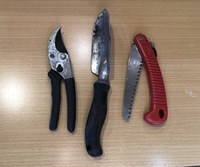Dakota Gardener: Clean and disinfect your garden tools for next year
(Click an image below to view a high-resolution image that can be downloaded)
By Esther E. McGinnis, Horticulturist
NDSU Extension
I’ve been watching a busy squirrel prepare for winter. It scurries around the neighborhood gathering acorns from all the oak trees. Like our wildlife, gardeners are busy with end of season tasks.
One of the final tasks is cleaning, disinfecting and putting away tools. Quality gardening tools are not cheap and should be carefully maintained before storing. Simple cleaning is not always enough because our tools frequently come into contact with diseased garden plants that harbor bacteria, fungi or viruses. To prevent disease transmission to plants next year, tools should be subjected to a two-step cleaning and disinfecting process.
The first step is to remove residual dirt, plant sap and debris. A stiff brush or a soapy scrub sponge can be effective in removing debris. Alternatively, a strong jet of water can be used to dislodge soil.
Once cleaned, the tool can then be disinfected to kill plant disease organisms. Gardeners have access to many home disinfectants but not all are considered equal in their ability to kill bacteria, fungi and viruses.
One of the worst disease organisms that can persist on tools such as pruners and saws is the fire blight bacteria that affects apple and pear trees. The University of California conducted an experiment testing the ability of Clorox® bleach, Lysol® concentrate, Pine-Sol®, rubbing alcohol (70%, 91% and 99%), Listerine® mouthwash, and hydrogen peroxide to kill the fire blight bacteria and to prevent disease transmission on tools. Of the tested products, soaking the tool for one or more minutes in Clorox, Lysol, and Pine-Sol was the most effective.
For fire blight, these three disinfectants can be diluted to one-part disinfectant to four-parts water and still be effective. After removing tools from the soak, an important step in the disinfection process is to allow the tools to air dry rather than wiping them dry.
While Clorox, Lysol, and Pine-Sol are quite effective at controlling this tough bacteria, an important consideration is the corrosiveness of the chemical compounds. Bleach and Pine-Sol are known to corrode metal tools. Rub some linseed or mineral oil on the metal after disinfection to prevent rusting over the winter.
Unfortunately, there are few tool disinfection studies for disease organisms other than fire blight. However, the general rule of thumb is to soak your tools for a longer period of time if the metal is pitted or if there are lots of nooks and crannies.
Personally, I use both Lysol and bleach. I would prefer to disinfect all my tools in undiluted Lysol® All-Purpose Cleaner because it doesn’t corrode metal. However, it is not cost-effective for larger tools and objects. Therefore, I soak small hand tools such as pruners and hand saws in Lysol for 2 to 3 minutes. These are also the tools that are more likely to come into contact with fire blight. With respect to larger tools such as shovels and tomato cages, I use a one-part bleach to 9-part water solution in a large bucket as my disinfectant.
NDSU Agriculture Communication – Oct. 11, 2023
Source: Esther McGinnis, 701-231-7406, esther.mcginnis@ndsu.edu
Editor: Kelli Anderson, 701-231-7881, kelli.c.anderson@ndsu.edu




